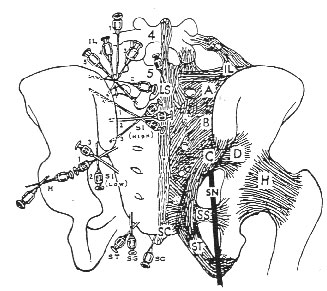◔
Sacroiliac Joint Prolotherapy: Difference between revisions
From WikiMSK
m (Text replacement - "Pelvis, Hip & Thigh" to "Pelvis, Hip and Thigh") |
mNo edit summary |
||
| Line 2: | Line 2: | ||
{{nonmainstream}} | {{nonmainstream}} | ||
Protocols vary for this procedure. | Sacroiliac joint prolotherapy is sometimes used to treat [[Sacroiliac Joint Pain|sacroiliac joint pain]]. Protocols vary for this procedure. | ||
==Study Protocols== | ==Study Protocols== | ||
| Line 11: | Line 11: | ||
Hoffman et al (Retrospective cohort): 15% dextrose in lidocaine monthly three times.{{#pmid:29609940|hoffman}} | Hoffman et al (Retrospective cohort): 15% dextrose in lidocaine monthly three times.{{#pmid:29609940|hoffman}} | ||
== Other == | |||
==Other== | |||
[[File:sacroiliac prolotherapy.jpg|thumb|400px|left|Needle Location used for injection of the sacroiiac ligaments. Trigger point of ligaments: (IL) Iliolumbar; (LS) Lumbosacral-supra and interspinus; (A,B,C,D,) Posterior sacroiliac; (SS) Sacroapinus; (ST) Sacrotuberus;(SC) Sacrococcygeal;(H) Hip-Articular; (SN) Sciatic nerve (from G.S. Hackett, Ligament and Tendon Relaxation. Charles C. Thomas Co., 1958)]] | [[File:sacroiliac prolotherapy.jpg|thumb|400px|left|Needle Location used for injection of the sacroiiac ligaments. Trigger point of ligaments: (IL) Iliolumbar; (LS) Lumbosacral-supra and interspinus; (A,B,C,D,) Posterior sacroiliac; (SS) Sacroapinus; (ST) Sacrotuberus;(SC) Sacrococcygeal;(H) Hip-Articular; (SN) Sciatic nerve (from G.S. Hackett, Ligament and Tendon Relaxation. Charles C. Thomas Co., 1958)]] | ||
{{clear|left}} | {{clear|left}} | ||
==References== | ==References== | ||
Revision as of 11:32, 4 March 2022
This article is a stub.
Sacroiliac joint prolotherapy is sometimes used to treat sacroiliac joint pain. Protocols vary for this procedure.
Study Protocols
Cusi et al (RCT): Dorsal interosseous injection, done under CT guidance, for clinically diagnosed source of pain. 22-g spinal needle. 5mL syringe, 1.8mL of 50% dextrose, 2.3mL bupivicaine 1%, 0.8mL iopamidol contrast. 0.8mL injected into the ligament as it moves up and down the ligament. [1]
Kim et al (RCT): Intraarticular injections. 25% dextrose solution, done by diluting 50% dextrose in bupivicaine.[2]
Hoffman et al (Retrospective cohort): 15% dextrose in lidocaine monthly three times.[3]
Other

Needle Location used for injection of the sacroiiac ligaments. Trigger point of ligaments: (IL) Iliolumbar; (LS) Lumbosacral-supra and interspinus; (A,B,C,D,) Posterior sacroiliac; (SS) Sacroapinus; (ST) Sacrotuberus;(SC) Sacrococcygeal;(H) Hip-Articular; (SN) Sciatic nerve (from G.S. Hackett, Ligament and Tendon Relaxation. Charles C. Thomas Co., 1958)
References
- ↑ Cusi et al.. The use of prolotherapy in the sacroiliac joint. British journal of sports medicine 2010. 44:100-4. PMID: 18400878. DOI.
- ↑ Kim et al.. A randomized controlled trial of intra-articular prolotherapy versus steroid injection for sacroiliac joint pain. Journal of alternative and complementary medicine (New York, N.Y.) 2010. 16:1285-90. PMID: 21138388. DOI.
- ↑ Hoffman & Agnish. Functional outcome from sacroiliac joint prolotherapy in patients with sacroiliac joint instability. Complementary therapies in medicine 2018. 37:64-68. PMID: 29609940. DOI.
Literature Review
- Reviews from the last 7 years: review articles, free review articles, systematic reviews, meta-analyses, NCBI Bookshelf
- Articles from all years: PubMed search, Google Scholar search.
- TRIP Database: clinical publications about evidence-based medicine.
- Other Wikis: Radiopaedia, Wikipedia Search, Wikipedia I Feel Lucky, Orthobullets,


